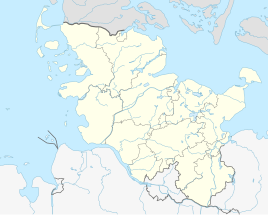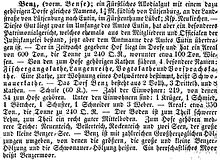Benzerhof estate
|
Benzerhof estate
Coordinates: 54 ° 12 ′ 26 ″ N , 10 ° 37 ′ 48 ″ E
|
||
|---|---|---|
|
Location of Gut Benzerhof in Schleswig-Holstein |
||
The Benz estate belonged to the Dukes of Oldenburg from 1711 to 1924 . From 1738 to 1778 it was the family fideikommiss (inalienable private property) of the Oldenburg family . In 1778 the Fideikommiss is abolished and Gut Benz becomes a princely allodial property (free property). The village of Benz belonged to the Allodialgut in the Principality of Lübeck . Today the village with the Benzerhof estate is part of the Malente community in the Ostholstein district in Schleswig-Holstein .
The fields have heavy loamy soil and loamy sandy soil (good medium soil ). But there are also some sandy areas and boggy meadows corresponding to the terminal moraine landscape in Holstein Switzerland . In the hunting grounds are deer , fallow deer and wild boar . Fallow deer are also kept in an enclosure near the farm buildings.
history
Benz is eight kilometers north of Eutin and five kilometers east of Neukirchen (Malente) on Kreisstrasse 1 between Sielbeck and Sieversdorf .
The village Benz was in 1215 mentioned for the first time when the Bishop Bertold from Lubeck to Pope Honorius III. asked to confirm his possessions.
According to the list of table goods, Benz had 14 farm positions around 1280. The Hufner were free farmers at that time .
1605–1639 The bailiff of Eutin, Jürgen von Stoyentin , bought a farm in Benz in 1605. The open courtyard gradually emerged from several hooves .
In 1639 the enlarged property passed from the son Jochim Stoyentin to the master hunter Köhn Wulff von Bassewitz and subsequently changed hands several times. In 1644 the prince-bishop's administration waived all taxes on the court.
The owners tried twice unsuccessfully to obtain the status of a noble estate for Gut Benz:
1661 when the Benz estate was sold by Gregorius Brocktorf to Otten Pogwischen and
1695 when Christoph Friedrich Graf Rantzau from Schmoel (~ 1623–1696) is the owner. He leased the Benz farm.
In 1710 the free court in Benz was given the name Gut .
1711–1738 Duchess Albertine Friederike Margravine von Baden-Durlach (1682–1755) bought the farm in 1711, and the farm was enlarged at the same time. Albertine was the wife of Christian August von Schleswig-Holstein-Gottorf, her granddaughter was the Tsarina Katharina the Great . In 1738 Albertine converted Hof Benz into a family entailment (inalienable private property) of the Dukes of Oldenburg .
Albertine Friederike bought the Benz estate (1682–1755) in 1711.
Prince-Bishop Christian August is Albertine's husband (1673–1726).
In 1727 Adolf Friedrich (1710–1781) became Duke of Oldenburg and Prince-Bishop of Lübeck . In 1751 he becomes king of Sweden.
Friedrich August von Schleswig-Holstein-Gottorf (1711–1785) succeeded his brother Adolf Frederich in 1750 as Prince-Bishop of Lübeck .
1738–1750 Adolf Friedrich Prince-Bishop of Lübeck (1710–1781), Albertine's son, buys the Benz estate from his mother. In 1744 he married Luise Ulrike von Prussia , a daughter of the soldier king . He was elected King of Sweden in 1743 and was not crowned King of Sweden until 1751 .
1750–1785 Friedrich-August , the younger brother of Adolf Friedrich, was Prince-Bishop of Lübeck and later Duke of Oldenburg (1711–1785). In 1752 he traveled incognito with the sonorous name "Graf von Benz" to Kassel to marry Princess Ulrike von Hessen-Kassel.
1785–1829 Peter I Grand Duke of Oldenburg (1755–1829) is the titular duke on behalf of his cousin Peter Friedrich Wilhelm (1754–1823) .
The Fideikommiss of 1738 was repealed in 1778 and the Benz estate became an allodial estate (free estate). In 1822 the current manor house was built as a half-timbered building. The manor house was later given an additional brick facing. By will of Duke Peter Friedrich Ludwig , the estate was granted the status of a domain of the Grand Ducal House in 1829 . With the house law for the Grand Ducal Oldenburg House of September 1, 1872 Benz came to the entails of the Grand Ducal House and after 1918 remained the private property of the House of Oldenburg.
Peter (I) Grand Duke of Oldenburg (1755–1829) from 1785 to 1803 also Prince-Bishop of Lübeck .
August I. Grand Duke of Oldenburg (1783-1853), taler coin with his likeness
Peter II. Grand Duke of Oldenburg (1827–1900)
Grand Duke Friedrich August von Oldenburg (1852–1931) sold the Benz estate in 1924.
1829-1853 August I. Grand Duke of Oldenburg (1783-1853)
1853-1900 Peter II. Grand Duke of Oldenburg (1827-1900)
1900-1924 In July 1923, the hardship of the inflationary period and the war on the Ruhr was reflected in the fact that the cowshed and barn burned down in the course of a wave of strikes. Then in 1924 Friedrich August (1852-1931), the last reigning Grand Duke of Oldenburg , (his property administration in Lensahn) sold the Benz estate to the government in Eutin . The Benz estate belonged to the Dukes of Oldenburg for six generations . During these 213 years, the Benz estate was leased continuously. The last tenant from 1918 to 1928 was the canning manufacturer Kohlsaat.
At the beginning of the 20th century the estate was 336 hectares in size . To the west of the farm lies the Großer Benzer See and to the north, close by, the Kleiner Benzer See . Benz was surrounded by numerous grand ducal woods, of which the larger ones were called the Big and Small Benz woods and the Schwonauer woods. The large wood is near Nüchel Großenholz. The small wood now borders the sports field. The Schwonauer Hölzung is today the state forest Schwonau.
1924-1933 The government in Eutin sold the estate to a manor owner Kuhnke in Silesia. In 1925 Adelbert von der Oelsnitz bought the estate from him. In 1926, Harald Graf Holck from Altona (1898-1952) bought the Benz estate. The larger forest areas remained State Forest Eutin (today: Schleswig-Holstein State Forests , Försterei Dodau). There are 200 hectares of arable land, 70 hectares of pasture and meadow left at Gut Benzerhof, plus the two Benzer lakes together 30 hectares and 10 hectares of forest. In 1929, Count Holck bought Gut Farve in addition to Gut Benzerhof .
Bertold von der Betten naval officer and farmer (1889-1970) with his wife Hedwig (1895-1988).
Melchior von der Betten Senate President (1886-1953). The brothers Bertold and Melchior bought Benzerhof in 1933.
Johann Georg (1912-1998) and Ilse Maria von der Betten managed the farm from 1954 to 1977.
Berno von der Betten Dipl.-Ing. agr. (1947-1984). He ran the Benzerhof from 1977 until his accidental death.
In 1933, Count Holck sold the Benzerhof estate to Bertold von der Betten , naval officer and farmer, and his brother Melchior von der Betten , Senate President in Hamburg. In 1952 the farm was divided between the two brothers. Dothardus von Weyhe and Eggert Wiese leased the Melchior farm one after the other. Alfred Soltau from Reinbek bought this farm with the small Benzer Holz and the two Benzer lakes in 1977 . On the remaining Benzerhof with 163 hectares, arable farming with a focus on wheat is successfully practiced . In 1971 dairy farming was given up and a fallow deer gate was set up in the small paddock near the farm buildings. The fifth generation of the von derdecke family has been at home at the Benzerhof for 80 years.
Coat of arms of the families at Benzerhof
Jürgen von Stojentin the bailiff of Eutin and his son Joachim - Benzerhof from 1605 to 1639
Jägermeister Köhn Wulff von Bassewitz and eight other owners - Benzerhof from 1639 to 1712
Otten von Pogwischen = Otto von Pogwisch - Benzerhof before and after 1641
Detlef and Gregorius Brocktorf - Benzerhof approx. 1670 to 1690
Christoph Friedrich Graf Rantzau at Schmoel - Benzerhof from around 1695 to 1711
Gut Benzerhof was owned by the Dukes of Oldenburg from the House of Schleswig-Holstein-Gottorf for 213 years - from 1711 to 1924
Harald Graf Holck and his descendants at Gut Benzerhof from 1926 to 1933 and at Gut Farve from 1929 to today
Is more than 80 years, the family of the ceiling on Good Benzerhof from 1933 to today
Fire at the Benzerhof
1923 on July 23rd at 3 a.m. in Benz the dairy farm (today Schwonauer Weg 6) burned down to the ground. Seven hours later at 10 a.m. the cowshed was also on fire . Then the fire jumped over to the barn and from there on to the old dairy (now Hauptstrasse 35). Before the fires in the courtyard, an arsonist at the cottage was noticed by Fraulein Dreis (today: Schwonauer Weg 16) and expelled, but he could not be identified later.
1934 on June 29th The cowshed burned down again at night. Luckily the cows were out in the pasture. The cause of the fire was electrical damage.
After the fire of 1923, the barn was rebuilt by G. Schümann Nüchel with an impressive self-supporting wooden beam construction and high brick walls. A rolling crane at a height of 12 m under the gable could unload and transport entire harvest wagons, a loader with around 200 sheaves . The rope drive of the crane was initially a horse and later an electric motor . The cowshed with grain storage was rebuilt in 1923 and 1934 as a brick building.
literature
- Henning Oldekop: Topography of the Duchy of Holstein. Volume 2, Kiel: Lipsius & Tischer 1908, p. 16f
- Lothar Estl: Hof Benz - a special case. Origin and legal status of a Eutinian property , yearbook for local history ( Heimatverband Eutin ), Eutin 1976 (pages 87-94)
- House law of the House of Oldenburg from 1872. Gut Benz is mentioned three times in the house law. Other Oldenburg estates are Güldenstein , Lensahner Hof , Stendorf , Manhagen , Wahrendorf near Lensahn , Mönchneversdorf and estates in Silesia . House Laws of Oldenburg
Web links
- The population distribution of the Principality of Lübeck In 1819 there were 254 inhabitants in Benz.
Individual evidence
- ↑ a b c d e f g Lothar Estl in Jahrbuch für Heimatkunde - Eutin 1976, pp. 87–94
- ↑ John v. Schröder 1841 Topography of the Duchy of Holstein and the Principality of Lübeck and the Free and Hanseatic Cities of Hamburg and Lübeck p. 44 Article on Benz printed in GenWiki
- ↑ Ulrich Pohle in the Eutin District Yearbook 1968, pp. 26–28
- ↑ Prof. Helmut Grieser in the village chronicle - Elke and Heinz Penkert: Benz - Eine Heimatgeschichte 2007, p. 3
- ↑ Family tree of the Rantzau family Schmoel House (PDF; 635 kB)
- ↑ Otto Rönnpag in the yearbook for local history - Eutin 1988, p. 86 also printed in the village chronicle - 2007: Elke and Heinz Penkert: Benz - Eine Heimatgeschichte p. 53
- ↑ Thassilo from the ceiling, Claudia bei der Wieden: goods and farms of the family from the ceiling. Stade 1998, p. 67
- ↑ Lothar Estl, also published in the village chronicle - 2007: Elke and Heinz Penkert: Benz - Eine Heimatgeschichte p. 31–36
- ↑ a b c Karl Hagelstein, teacher 1935, printed in the village chronicle - Elke and Heinz Penkert: Benz - Eine Heimatgeschichte 2007, p. 7
- ↑ Oldekopp (lit.), p. 17
- ↑ Master data of the Holck Haus Farve family
- ↑ Family tree of the Holck family (Danish)
- ^ Village chronicle - 2007: Elke and Heinz Penkert: Benz - Eine Heimatgeschichte p. 49, 51 and 52
- ↑ a b Village Chronicle - 2007: Elke and Heinz Penkert: Benz - Eine Heimatgeschichte p. 52 and 162

























